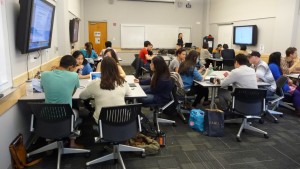
Active learning classroom at Berkeley’s Educational Technology Center (2014) https://ets.berkeley.edu
This term in my undergraduate medieval seminar I tried something new: I did not lecture at all. Instead, I assigned a secondary reading for each primary reading, then informed the students that the secondary reading was the lecture, and that when they came to class I would assume that they understood it perfectly (and would hold them responsible for its contents), but would answer as many questions as they had about it. Similarly, I made it clear that I would assume they understood the primary readings perfectly unless they had specific clarifying questions about it. I then dedicated a Q&A session for primary and secondary texts in each class meeting, and the rest of the session to ‘active learning’ activities in which the students engaged with the readings in various ways, as follows below. I’ve compiled them into a pdf you can download here for your convenience.
I don’t know if this approach is or is not more pedagogically sound than the traditional lecture. I do know that is was a change of pace for me, and that they appeared to be more engaged and less bored over the course of a three-hour seminar that met from 5:00-8:00pm. I would love to hear about your own experiences trying out these kinds of activities in the literature classroom.
The following techniques are slight modifications of active learning strategies that I found on websites like this one and this one. Many of them involve the use of 5×7 inch index cards, which are great for focusing attention, limiting output, and can be projected on a screen using a document camera, which is a simple, efficient way for using student-generated content to focus class attention.
Linguistic awareness: On an index card, Identify 3 characteristics of the medieval language in question (provided it is a vernacular language) in a passage on board, then render the passage into modern. You can also collect the cards and spot-teach interesting or problematic features on the board.
Summary: each pair is assigned two chapters to summarize, then writes summaries on board in order to form a summary of the entire reading.
Synthesis secondary/primary: Main idea of secondary reading: on an index card, write one sentence that expresses the main idea of the secondary reading. Then explain why it is useful for understanding the primary reading.
Linkage: In pairs. On an index card, write one short passage each from the primary and secondary texts. Prepare for five minutes. Explain how they are related. Instructor can project index card with document camera so that entire class can follow explanation.
Quiz: Each pair writes a quiz question for the reading, write it on the board. Class votes on top four questions then takes the quiz and reviews the answers in pairs, reporting back to group.
Role Play: In pairs, one student as Interviewer and one as a character (historical or fictional) from the primary reading. Each pair writes five questions and five answers for the character. Each answer is based on a citation from the primary text. Write citations on cards, interview conducted with notes but not reading directly from cards. Can give hilarious results.
Name that author: In two teams. On index cards, each team selects 10 characteristic quotes from each author that voice different ideas. Shuffle the cards and number them 1-20. On a separate card, keep a list linking each card to the correct author. Switch decks with other team, try to sort them by author. Student reads cards, student from opposing team tells them if it is correct. Third student tallies correct/incorrect guesses. Team with most correct guesses wins a prize.
Transcribe section of medieval manuscript: It is getting progressively easier to find decent quality images of the manuscripts of the texts we are teaching. I’ve found a transcription exercise is a good way to bring a long seminar to a tranquil landing.
Discussion of peer’s written assignment: A productive way to leverage a written assignment for classroom discussion. In pairs, explain your written analysis of the primary text to your partner. Join with a second pair; then each explains their partner’s analysis to the larger group of four. This is a nice structured way for students to exchange their ideas and analyses of the primary text.
Paraphrase academic Spanish: in pairs, choose a paragraph from the secondary reading. Write a paraphrase of it in normative Spanish on an index card. Then join with another pair and explain the paragraph.
Deconstruct the narrative: In pairs, select six short passages from the primary text and write them on six index cards. Do not write the page numbers on the cards. On a separate card, identify the passages by catch words and record the page numbers. Trade cards with another pair. Each pair tries to put the passages in the correct order.
 Prediction: On an index card, write three predictions for what will happen in the following chapters of the primary reading. Include justifications for your predictions. Students can then exchange predictions and report to the larger group, or instructor can post individual predictions on a document camera to share with the class.
Prediction: On an index card, write three predictions for what will happen in the following chapters of the primary reading. Include justifications for your predictions. Students can then exchange predictions and report to the larger group, or instructor can post individual predictions on a document camera to share with the class.
Questions about readings: On an index card, write your question about a specific passage in the reading (primary or secondary). Note the page number and location of passage. Instructor collects cards and reads/answers selected questions.
Flash analysis: Instructor shows a short passage from primary text on board/screen. In pairs or groups, students identify the passage and explain its significance. Give them a set time to work on their analysis. This can be gamified if you hand out a different passage to each group on a slip of paper, gives everyone five minutes, and then shows each of the passages on a slide as the groups present their analyses. Then the other teams can write down ratings for each analysis; ratings are aggregated at the end.
3-2-1 for secondary reading: In pairs, on an index card, write 3 key concepts from secondary reading, one example from the primary reading to illustrate one of the concepts, and 1 question. Students or instructor can then write the key concepts on the board.
 Formal debate: Instructor gives class a resolution based on their reading of the primary text. Class divides into four teams (A vs B, C vs D), for two separate debates. In each debate, one team argues pro, the other team argues contra. In each debate, one student from the teams not currently debating keeps time and another tallies votes on chalkboard. Instructor places the following conditions on participants: (1) All members of each team must speak during each turn, (2) Everything they say must be supported by specific textual quotation (primary or secondary). (3) In your rebuttals, you must address specific points made by the opposing team and demonstrate why they are not valid. Debate format: (1) A presents pro argument (4 min.), (2) B presents contra argument (4 min.), (3), A rebuts contra argument (2 min.), (4) B rebuts pro argument (2 min.). Teams C and D vote on winner of debate. Repeat for teams C and D, with A and B voting on winner.
Formal debate: Instructor gives class a resolution based on their reading of the primary text. Class divides into four teams (A vs B, C vs D), for two separate debates. In each debate, one team argues pro, the other team argues contra. In each debate, one student from the teams not currently debating keeps time and another tallies votes on chalkboard. Instructor places the following conditions on participants: (1) All members of each team must speak during each turn, (2) Everything they say must be supported by specific textual quotation (primary or secondary). (3) In your rebuttals, you must address specific points made by the opposing team and demonstrate why they are not valid. Debate format: (1) A presents pro argument (4 min.), (2) B presents contra argument (4 min.), (3), A rebuts contra argument (2 min.), (4) B rebuts pro argument (2 min.). Teams C and D vote on winner of debate. Repeat for teams C and D, with A and B voting on winner.



This is great! Did the students like it? At least in the sciences, there’s a lot of evidence for the efficacy of active methods, but it can be a tough sell for the students — though it seems to be getting easier.
Great activities! In a class with the format of active learning and less lecturing, I wonder what the role of a TA would be. What would you suggest?
Brilliant Idea David. I know I’ve never comment on your website before but just found it online. Great activities for students + quiz and role play. Brilliant. Hope to see more articles like this. website design worcester